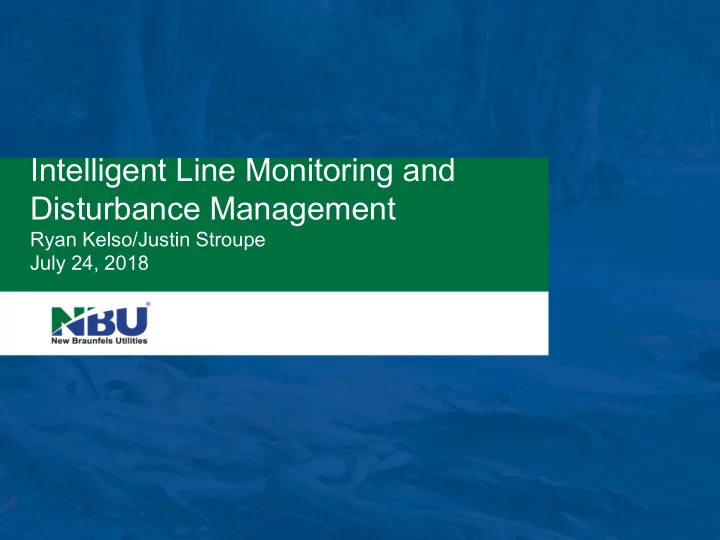

Intelligent Line Monitoring and Disturbance Management Ryan Kelso/Justin Stroupe July 24, 2018
2 New Braunfels Utilities Overview � 41,373 Electric Meters � 99.5% AMI (Itron Network Solutions) � 160 sq. mi. Electric Territory � 619 miles Primary OH � 285 miles Primary UG � 40 Distribution Feeders � 20 miles of 138kV transmission � 24/7 Control Center Operations
3 The Desire � Enhance visibility of the distribution system � Improve system resiliency � Reduce outage duration - SAIDI � Lower outage frequency - SAIFI � Leverage existing AMI communications network to connect grid-edge devices
4 Existing Tools � Fault Indicators (flashing lights) � Milsoft Outage Management System � Itron Network Solutions AMI � Intelligent substation relays
5 The Solution: Sentient Proven technology ≈ $100+ million invested in 60,000 intelligent sensors developing and delivering shipped. sensing technology Serving 8 of top 10 largest utilities in North America Multiple communications Highest fidelity options oscillography on the market (>7,800 samples/second)
6 MM3: Sentient Core Sensing Solution Overhead Feeder Monitoring System � Continuously sampling, 130 Sample/cycle Current and E- field capture � GPS for location and precision timing � MM3 supports multiple communications options: Itron, L+G, and LTE technology � Patented power harvesting technology requires no servicing or maintenance for the life of the product
7 MM3 Intelligent Sensor � Easy installation � Local annunciation: daylight-visible LED � Embedded fault detection algorithms: � Fixed Trip, Auto-range, Rate of Change (di/dT) � Inrush restraint, Loss Of Source � Event Details: � Fault magnitude, related hi-res waveform
8 Ample Software Foundation for Sentient’s Grid Analytics System (GAS) � Complete sensor management � Multiple DNP masters – directly connect to devices � Analytics Software: � Interval Logging - Current and Conductor Temperature per phase � Fault Location along the feeder and on what phase � Phase Identification � E-Field – monitors reverse flow of current � Disturbance Management (Momentary/Incidents) – Waveforms � Easy to integrate � APIs for historian integration � Role level security
9 Pilot Approach: 9 Sensors � Deployed 3 sets of sensors on 2 distribution feeders � Deployed at 2 substation feeder exits and 1 feeder midpoint � Developed ROI measurement � Value of Lost Load + Operational Cost per SAIDI Minute � Focused on disturbance management
10 Disturbance Management what is a disturbance? � A disturbance is a small and momentary change in current/e-field waveforms. � Characteristics of a disturbance are: � Disturbances usually do not cause a sustained power interrupt � Magnitude is usually 1-5 times normal current (faults can cause > 15 times increase in current) � Duration usually lasts less than 5 cycles (5 – 80 milliseconds) � Distortions: 1st to 50 harmonic content (Sentient can detect up to 31st harmonic in underground solution)
11 Pilot Results: Disturbance Management Control Center sees elevated Trees grow into lines disturbance counts Electric Ops finds tree making contact with B&C phase, trims Avoided SAIDI: 2.66 min. trees to prevent Avoided Cost: $16,770 outage, disturbances return to normal
12 Change in workflow If fault data is Operations available will make No report Operator sees provide decision on usually fault prediction of whether to provided fault run out circuit Provides Operations Operator operations makes repairs Runs fault receives fault with and reports location tool data from predicted back results in OMS Sensors location of for ROI fault Calculation
13 Calculating ROI Avoided Costs(ROI) = Value of Lost Load (VOLL) + Operational Cost Per SAIDI Minute(OCPSM)
14 Pilot Results � Delivered 2.66 SAIDI minute reduction through disturbance management � $16,770 in VOLL+OCPSM savings � SAIFI reduction � Communication through AMI network worked as designed
15 Phase 2: 60 Sensors � Deployed 20 sets of sensors on 18 distribution feeders � Deployed on feeders with old relays that did not report fault amplitude � Positioned at midpoint of circuit
16 Benefits: Phase Identification � Identifies phase miss-match and reports detected phase
17 Benefits: Phase Balancing � Allow decision making based on facts not estimates � Planning, load flow, dynamic loading application data
18 Benefits: Disturbance Monitoring
19 Benefits: Fault Detection � Enables waveform capture, storage and analysis � Precisely determine boundaries of disturbance using patent-pending algorithm � Supports automatic or manual retrieval of waveforms � Foundational component for disturbance analysis and event categorization � Capture momentary and transient events for further analysis � Instrument-class, sampling rate, “Oscilloscope on the wire”. True 130 samples/cycle.
20 Benefits: Fault Locating
21 Benefits: Temperature Monitoring
Predicted Location Actual Location 22 Success Fault Waveform
23 Success Faulted Element: Broken Insulator Cause: Lightning Avoided SAIDI: 2.66 min. Avoided Cost: $28,329.81
24 Success Issue Fixed on 7/20 – Disturbance counts fall off
25 Phase 3: 66 Sensors � Currently deploying 22 sets of sensors � Deploying at feeder substation exits to maximize coverage for disturbance management
26 Results
27 Results
28 Results
29 Results � Avoided SAIDI: 5.32 Minutes � Avoided Costs: $45,100.30 � Avoided Interruptions: 1,760 � SAIFI Reduction: 0.04 � Improved System Resiliency � Improved Customer Experience
30 Lessons Learned � Deployment at substation feeder exit yields maximum disturbance management coverage � Get it in the hands of System Operators early � Develop metrics, track and brag on success – resulted in increased buy-in
31 Future Plans Continue deployment of MM3 Q3 2018: Pilot ZM1 “Low Amp” Line Monitor Q4 2018: Pilot UM3+ UG Q4 2018: Launch NBU Line Monitor UAV Program
32 Questions?
Recommend
More recommend